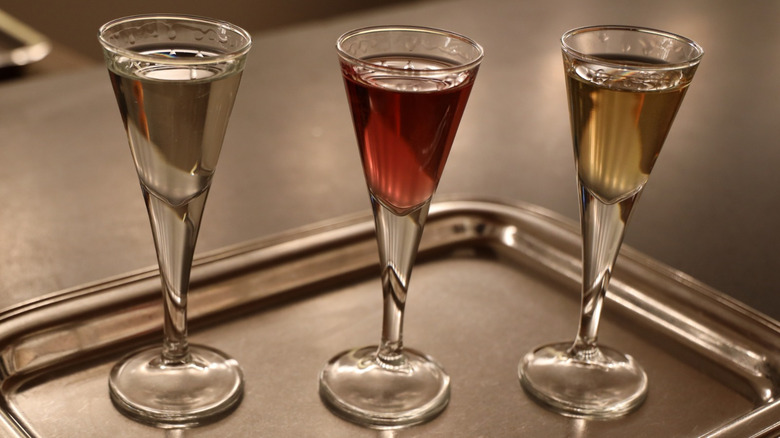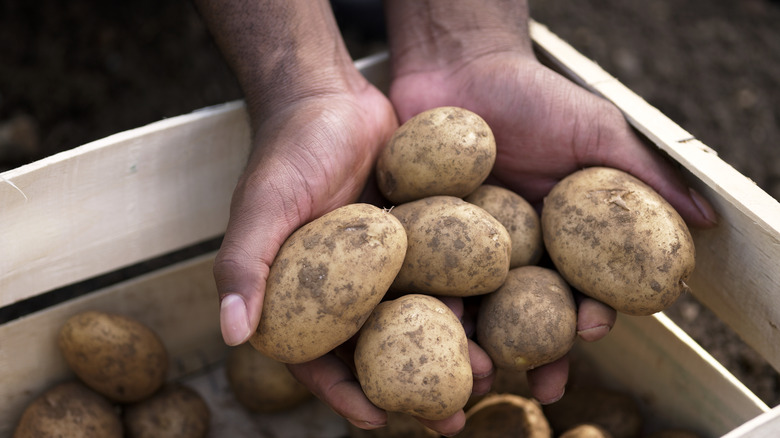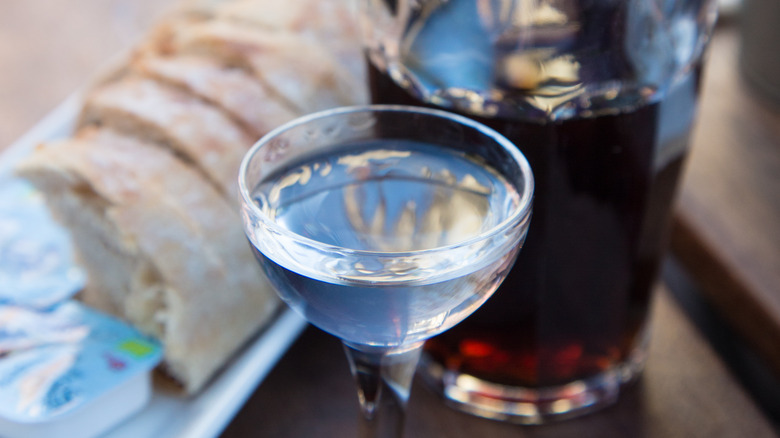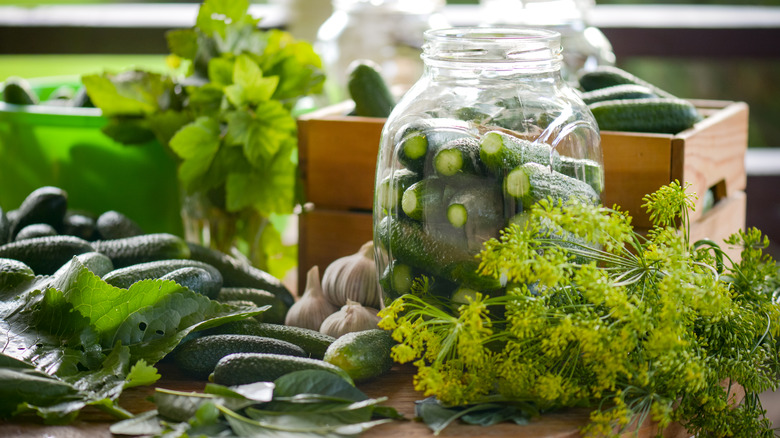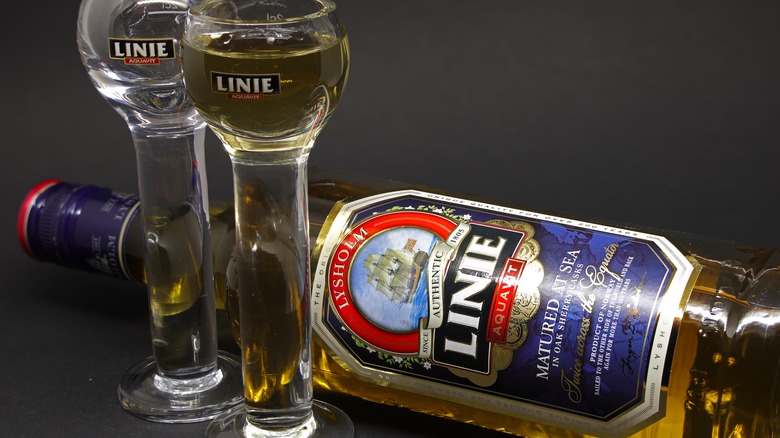Aquavit Is The Unique Scandinavian Liquor With Pickle-Like Qualities
From the lowlands of Northern Germany to the vast fjords of Norway, and even to the lakes and woodlands of Finland, aquavit is the spirit that unifies all of Scandinavia. First mentioned in the 15th century and literally meaning "water of life," aquavit was once prized for its healing qualities and used in gunpowder. Today this neutral-grain spirit has evolved into a popular drink, and is made in a myriad of different styles and consumed in traditionally unique ways depending on which Scandinavian country you're in. However, one quality remains consistent across Nordic borders, and that's the spirit's pickle-like flavors, stemming from the herbs and botanicals that Scandinavians have used and beloved for centuries.
To be classified as aquavit, the liquor must be a neutral-grain spirit flavored primarily by caraway. Dill is another commonly-used botanical, and from there different regions and distillers flavor their aquavit with supplementary botanicals ranging from cardamom and coriander seeds to star anise. Some, like dill and coriander, would have been grown locally, and the more exotic spices would have been brought to Scandinavia hundreds of years ago by the spice trade. This combination of spices became the primary flavors used in the region's bread, stews, and — you guessed it — pickles! The essence of aquavit reflects the food, history, and literal spirit of the people of Scandinavia.
How Aquavit is made
Aquavit starts its life as an agricultural ethanol, which is a neutral-grain spirit that adheres to strict regulations as to how it's allowed to be distilled. This process involves massive stills (commonly continuous stills) that take mash made from grains like wheat, barley, corn, or potatoes and generate a distillate of very high proof. After distillation, the base spirit is much like gin. In fact, the only thing that separates the two is the botanicals that eventually flavor the spirit. In the case of gin, it's juniper berries; in the case of aquavit, it's primarily caraway seeds.
Caraway seeds and other select botanicals are then put into the ethanol to be distilled again. The gentle heating of this process creates vapor containing the desired flavor particles, which gets captured back in liquid form and then has water added to it in the end to reach the desired proof. This process of distilling with botanicals is a key feature of aquavit, unlike the process used to make Schnapps, which are just base liquors like vodka infused with flavors like fruit, peppermint, or caraway. Many people can make the latter at home with a bottle of neutral spirit of their choice, but it can't legally be called aquavit.
Danish vs. Swedish vs. Norwegian Aquavit
In Denmark and Sweden, aquavit is commonly sold as a clear-colored spirit to be enjoyed served cold (often straight from the freezer) and to accompany a glass of beer, a plate of local delicacies, and lots of enthusiastic drinking songs. Both of these countries also distill the majority of their aquavit from grain only but with some big differences in which botanicals take center stage. In Denmark, they like to feature dill, coriander, and caraway more prominently. In Sweden, aquavit is characterized more by anise and fennel notes, making it a great drink to pair with pickled herring, which is an iconic Swedish delicacy.
Norwegian aquavit is much different than its Scandinavian cousins. Firstly, it's often distilled with a potato-heavy mash (pun not intended), giving the base spirit a more pronounced flavor than aquavit featuring only grains. Secondly, there is a tradition of barrel-aging the aquavit. By aging the spirit in sherry oak casks, the clear aquavit takes on an amber hue and develops mild sweetness with hints of wood spice from the barrels. Norwegian aquavit features the usual flavorings, but might also include orange or lemon peel. No matter where you find yourself in Scandinavia, though, do as the locals do and enjoy as much aquavit as you can.
What does Aquavit taste like?
As you can probably guess, the baseline flavor of aquavit is caraway, with a smattering of dill, fennel, aniseed, and citrus depending on where it was made. And although these aromatics might have you imagining a mouthful of alcoholic pickle juice, aquavit is much more subtle. This spirit is relatively dry, meaning it is low in sweetness. And since it is typically bottled at an ABV range of 42% to 45%, the high alcohol content enhances the natural pepperiness of the botanicals to result in a spicy quality when drinking.
The Norwegian practice of barrel aging aquavit, accidentally discovered in the 19th century when a ship returned to port after a long voyage with unsold bottles of aquavit, gives their version a very different flavor from the clear counterparts elsewhere. This process rounds out the sharp edges of aquavit and gives it a more mature quality such as you'd find in Scotch whisky. This additional character makes it something to be enjoyed slowly at room temperature in order to appreciate the complexities in flavor, as opposed to being knocked back in chilled shots while shouting Viking war chants.
Other uses for Aquavit
Aquavit isn't the most versatile spirit to cook with, since its flavor profile is more distinctive than other common cooking alcohols like vodka, rum, and brandy. However, one need not look further than pickles. Aquavit can be used to make a quick pickle by subbing it in for water in the brining solution. The natural flavors occurring in aquavit compound beautifully with the other herbs and spices in the brine so it's practically a match made in heaven. And while it does make the pickles boozy and not appropriate for kids, the result is still delicious and crunchy pickled vegetables that go well with Swedish meatballs, on sandwiches, on charcuterie boards, and in martinis.
Speaking of martinis, budding mixologists will be happy to learn that aquavit is a great cocktail spirit, though it's mostly used that way in the U.S. Aquavit could slip easily into the classic Moscow Mule. The sweetness and subtle spice of ginger ale pairs well with the flavors of aquavit, and makes for a more interesting drink than one with vodka as the base spirit. For a more iconic aquavit cocktail, home bartenders should try mixing a Norwegian Wood. This drink features aquavit, sweet Vermouth, Applejack Brandy, and yellow Chartreuse, culminating in a funhouse of flavors that will leave you feeling like you're taking a summer walk in a Scandinavian forest. Another classic Scandinavian drink, Glogg, is a warm, spicy punch featuring aquavit, wine, sugar, sweet spices, almonds, and raisins.
Where to buy Aquavit
Although the more exclusive and interesting styles of aquavit might require a trip to Scandinavia, you'll find plenty to sample in stores and online in the U.S. One of the most common aquavit varieties curious American drinkers can try is Lysholm Linie. Distilled from potatoes, aged in sherry casks, and transported by boat across the world during the aging process, it's a great place to start for people who are fans of barrel-aged drinks like bourbon and reposado tequilas.
Curiously enough America has experienced its own small aquavit distillery movement, propagated by spirit craftsmen who want to spread the gospel of this Scandinavian drink. Unlike drinks such as Champagne and tequila, there are no geographic restrictions on aquavit, which means as long as distillers have access to the right botanicals, this spirit can be made anywhere. Popular American-made aquavit includes Venus, Tatterall, and Long Roach Distillers, which are produced in California, Minnesota, and Michigan respectively. These aquavit varieties carry price tags in the range of $30 to $50, which isn't too steep of a price to pay to support passionate local distillers. Skol!
